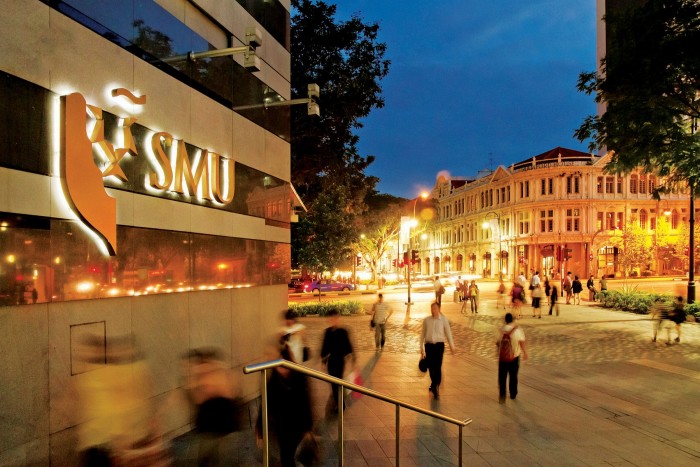Masters in Finance 2021 rankings: methodology and key

Roula Khalaf, Editor of the FT, selects her favourite stories in this weekly newsletter.
This is the 10th edition of the FT Global Masters in Finance rankings, which list both pre-experience programmes and post-experience degrees.
The FT defines pre-experience programmes as those aimed at students with little or no professional experience, while post-experience programmes require participants to have worked in finance. Most full-time programmes are aimed at pre-experience students.
Programmes must meet strict criteria to be eligible. They must be full-time, cohort-based and have a minimum of 30 graduates each year. Finally, the schools must be accredited by either AACSB or Equis.
A total of 79 schools took part in the 2021 edition of these rankings, 77 in the pre-experience ranking and five in the post-experience listing. Three schools, Amsterdam Business School, London Business School and Singapore Management University’s Lee Kong Chian, took part in both.
FT Masters in Finance rankings 2021

Find out which schools are in our ranking of post-experience and pre-experience postgraduate finance programmes. Also, learn how the tables were compiled and read the rest of our coverage.
The rankings are based on information collected in two separate surveys. The first is of the business schools and the second of alumni who completed their degrees in 2018.
For a school to be eligible for the rankings, at least 20 per cent of its alumni must respond to the FT survey, with a minimum of 20 completed surveys. Due to the pandemic, the FT considered schools with a lower response rate. In total it surveyed 6,178 graduates from pre-experience programmes and 314 alumni from post-experience courses. The two surveys achieved a response rate of 36 per cent and 39 per cent respectively.
There are 17 different categories in the pre-experience ranking, and alumni responses inform seven categories that together constitute 58 per cent of the total weight. The other 10 categories are calculated from the school data and account for the remaining 42 per cent.
The post-experience table has 16 categories, and alumni responses inform seven criteria that make up 62 per cent of the total weight. The remaining nine categories are taken from the school data and account for 38 per cent.
In both rankings, the current average salary of alumni has the highest weighting: 20 per cent. Local salaries are converted to US dollars using purchasing power parity rates supplied by the International Monetary Fund. The salaries of non-profit and public service workers, and full-time students, are removed. Salaries are normalised by removing the highest and lowest salaries reported.
More stories from this report
Scramble for places on Masters in Finance courses
Masters in Finance rankings 2021: the trends that matter
Teaching recognition award for excellence in sustainable finance education
Global push to boost financial literacy
Women shy away from senior finance careers
More opportunities to study for specialist financial skills
The pre-experience ranking measures average salary increase between the first post-masters job on graduation and today — a timespan of about three years. The post-experience ranking calculates the average salary difference from before starting the masters to now — a timespan of about four years. Salary increase has a respective weight of 10 per cent and 20 per cent in each ranking. Half of this figure is calculated according to the absolute increase and half according to the relative percentage increase (the figure published in the table).
Data provided by schools are used to measure the diversity of teaching staff, board members and students by gender and citizenship, plus the international reach of the programme. For gender criteria, schools with a 50:50 (male:female) composition receive the highest score. When calculating international diversity, in addition to schools’ percentage of international students and faculty — the figures published — the FT also considers the proportion of international students from each country of citizenship.
For the post-experience rankings, however, the calculations of value for money differ in that the total cost of the degree also includes the opportunity cost — the cost of not working during the programme.
The FT did not publish the Masters in Finance rankings in 2019. All alumni criteria use information collected from 2021 and, if available, 2020. Responses from 2021 carry 60 per cent of the total weight and those from 2020 account for 40 per cent, except for salary data which is 50 per cent for each year.
Finally, a relative FT score is calculated for each school. First, Z-scores — formulas that reflect the range of scores between the top and bottom schools — are calculated for each ranking criterion. These scores are then weighted, according to the weights outlined in the key to the ranking, and added together to give a final score. Schools are ranked accordingly, creating the FT Masters in Finance rankings.
Judith Pizer of Pizer-MacMillan acted as the FT’s database consultant
Key to the rankings
Weights for the ranking criteria are shown below in brackets — (pre-experience) [post-experience] — as a percentage of the overall ranking.
Salary today US$ (20) [20]: Average alumnus salary three years after graduation, US$ purchasing power parity (PPP) equivalent†
Salary percentage increase (10) [20]: For pre-experience alumni, this is the average difference in their salary between graduation and today, but for post-experience alumni, the difference is from before the masters to now†
Value for money (5) [3]: Calculated according to alumni salaries today, tuition fees and other costs†. For post-experience, the average course length is included in the calculation.
Career progress (5) [5]: Calculated according to changes in the level of seniority and the size of company alumni are working for between graduation and now (for pre-experience) or before their masters and today (for post-experience)†
Aims achieved (5) [3]: The extent to which alumni fulfilled their goals†
Careers service (5) [3]: Effectiveness of the school careers service in terms of career counselling, personal development, networking events, internship search and recruitment, as rated by their alumni†
Employed at three months % (5) [3]: Percentage of the most recent completing class that found employment within three months of finishing their programme. The figure in brackets is the percentage of the class for which the school was able to provide employment data and is used to calculate the school’s final score in this category. Not all schools have employment data for their entire cohort*
Female faculty % (5) [5]: Percentage of female faculty
Female students % (5) [5]: Percentage of women on the masters course
Women on board % (1) [1]: Percentage of women on the school advisory board
International faculty % (5) [5]: Calculated according to faculty diversity by citizenship and the percentage whose citizenship differs from their country of employment (published figure)
International students % (5) [5]: Calculated according to the diversity of current students by citizenship and the percentage whose citizenship differs from their country of study
International board % (1) [1]: Percentage of the board whose citizenship differs from the school’s home country
International mobility (8) [8]: Based on alumni citizenship and the countries where they worked before their masters, on graduation and three years after graduation†
International course experience (8) [8]: Calculated according to whether the most recent completing masters class carried out exchanges and company internships in countries other than where the school is based. For 2021, an average calculation was taken from the past two years’ international course experience data (2021 and 2020), if available. For schools that have taken part for the first time this year, only data from the 2021 survey were used†
Extra languages (1) [n/a]: The number of languages required on graduation, excluding English
Faculty with doctorates % (6) [5]: Percentage of full-time faculty with doctoral degrees
For information only (not used in the rankings):
Average course length: Average completion time of the programme for the latest graduating class
Company internships: Percentage of the most recent graduating class that completed an internship as part of the masters programme
Overall satisfaction: Average evaluation by alumni of the masters course, scored out of 10. They were asked to rate their overall satisfaction, on a 10-point scale
For gender-related criteria, schools with 50:50 male/female composition receive the highest possible score
† Includes data from current and previous ranking where available
* Class that completed masters between April 2020 and March 2021
Comments